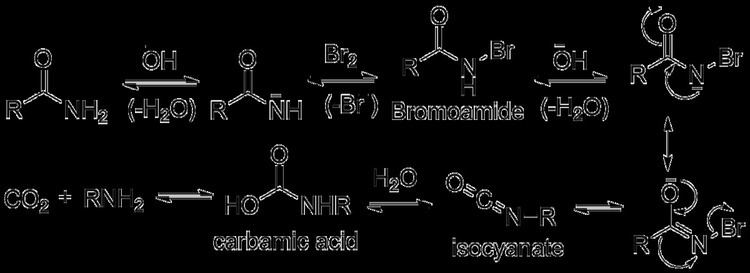 | ||
Named after | ||
The Hofmann rearrangement is the organic reaction of a primary amide to a primary amine with one fewer carbon atoms.
Contents
The reaction is named after its discoverer - August Wilhelm von Hofmann. This reaction is also sometimes called the Hofmann degradation or the Harmon Process, and should not be confused with the Hofmann elimination.
Mechanism
The reaction of bromine with sodium hydroxide forms sodium hypobromite in situ, which transforms the primary amide into an intermediate isocyanate. The formation of an intermediate nitrene is not possible because it implies also the formation of an hydroxamic acid as a byproduct, which has never been observed. The intermediate isocyanate is hydrolyzed to a primary amine, giving off carbon dioxide.
- Base abstracts an acidic N-H proton, yielding an anion.
- The anion reacts with bromine in an α-substitution reaction to give an N-bromoamide.
- Base abstraction of the remaining amide proton gives a bromoamide anion.
- The bromoamide anion rearranges as the R group attached to the carbonyl carbon migrates to nitrogen at the same time the bromide ion leaves, giving an isocyanate.
- The isocyanate adds water in a nucleophilic addition step to yield a carbamic acid (aka urethane).
- The carbamic acid spontaneously loses CO2, yielding the amine product.
Variations
Several reagents can substitute for bromine. Sodium hypochlorite, Lead tetraacetate, N-bromosuccinimide, (bis(trifluoroacetoxy)iodo)benzene, and 1,8-diazabicyclo[5.4.0]undec-7-ene (DBU) can affect a Hofmann rearrangement. In the following example, the intermediate isocyanate is trapped by methanol, forming a carbamate.
In a similar fashion, the intermediate isocyanate can be trapped by tert-butyl alcohol, yielding the tert-butoxycarbonyl (Boc)-protected amine.
The Hofmann Rearrangement also can be used to yield carbamates from α,β-unsaturated or α-hydroxy amides or nitriles from α,β-Acetylenic amides in good yields (≈70%).
For Amiloride, hypobromous acid was used to effect Hofmann rearrangement.
